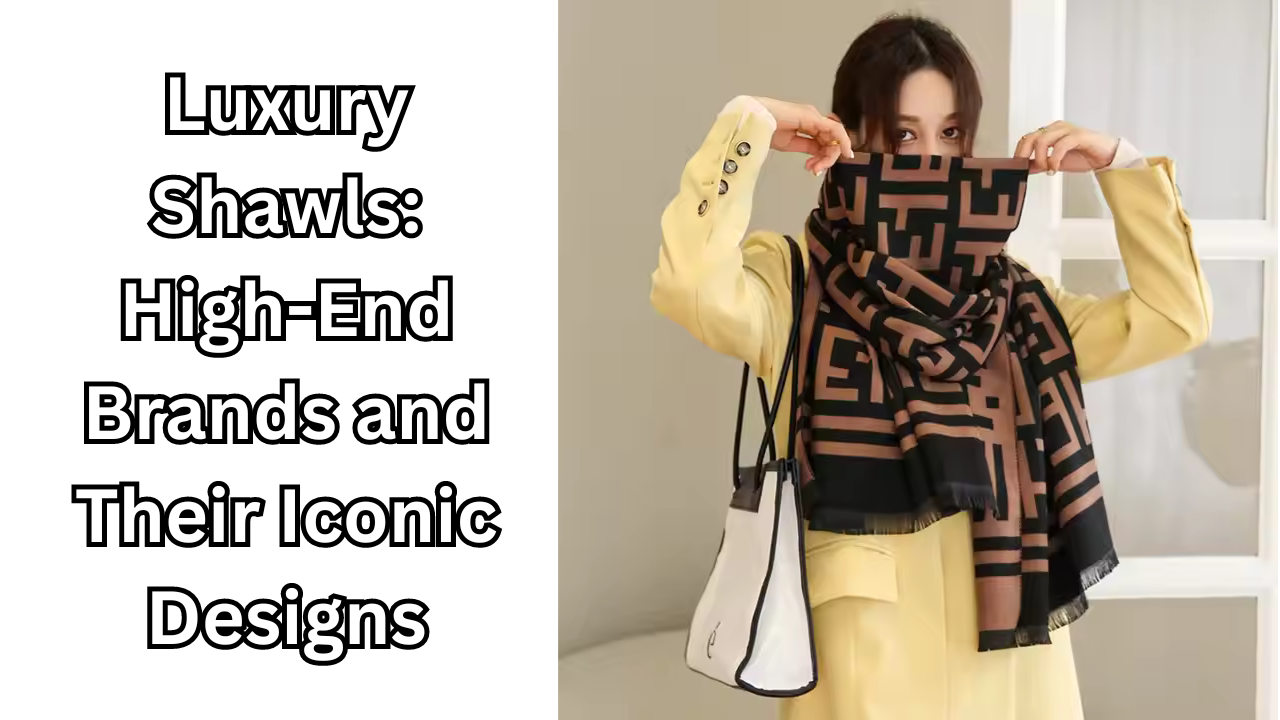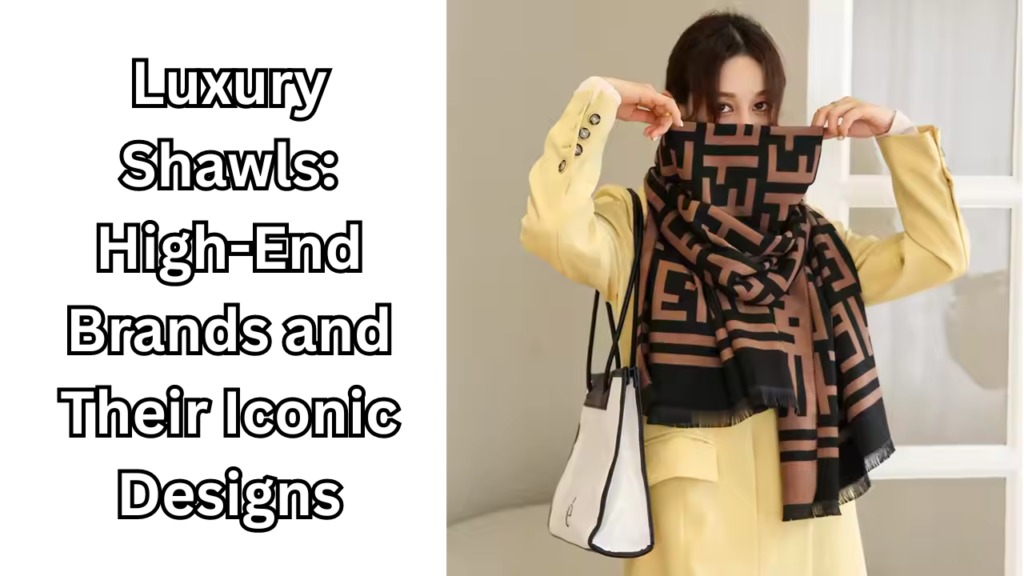

Table of Contents
Introduction
Shawls have long been revered in fashion as symbols of both elegance and versatility. Originating from ancient cultures, these versatile garments have transcended time and geography, evolving into a quintessential accessory in modern wardrobes. From their humble beginnings as functional pieces providing warmth and protection to their role as iconic fashion statements, shawls have cemented their place in the annals of style.
In the realm of high fashion, luxury shawls represent the pinnacle of opulence and sophistication. Crafted with meticulous attention to detail, these high-end pieces are more than mere accessories; they are a testament to artisanal skill and an expression of refined taste. Luxury shawls, often adorned with intricate patterns and made from the finest materials, are designed to elevate any ensemble, offering a touch of grandeur and exclusivity. The allure of these shawls lies not only in their aesthetic appeal but also in their ability to convey a sense of prestige and individuality. As we delve into the world of luxury shawls, we uncover a tapestry of iconic designs and celebrated brands that define the essence of high-end fashion.
Historical Context of Luxury Shawls
Shawls have journeyed through centuries of fashion, transforming from traditional garments into symbols of high fashion and luxury. Their evolution reflects broader cultural shifts and historical events that have shaped their design and significance.
Evolution from Traditional to High Fashion
Originally, shawls were functional items worn for warmth and protection, made from materials like wool, silk, and cashmere. In regions such as the Indian subcontinent and the Middle East, intricate weaving techniques and local craftsmanship produced exquisite shawls, such as the Kashmiri Pashmina and the Persian Kerman. These traditional shawls were often handwoven with detailed patterns, reflecting the artisanal skills and cultural heritage of their regions.
As global trade expanded and fashion became increasingly intertwined with luxury, shawls began to transition from practical wear to high fashion statements. The 19th and early 20th centuries marked a significant shift as Western designers began to incorporate luxurious shawl designs into their collections. Influenced by Eastern aesthetics and materials, designers such as Coco Chanel and Yves Saint Laurent elevated the shawl from a functional accessory to a coveted fashion piece.
Influence of Historical Events and Cultural Shifts
The 19th century’s colonial and trade expansions played a pivotal role in this transformation. European fascination with Eastern textiles led to the importation of lavish shawls and the adoption of Eastern-inspired designs. The introduction of the Jacquard loom and advancements in textile technology further facilitated the creation of intricate patterns and high-quality materials.
The mid-20th century saw the rise of iconic fashion houses, such as Hermès and Louis Vuitton, which embraced the shawl as a symbol of luxury and sophistication. The post-World War II era brought about a renewed emphasis on opulence and exclusivity, with luxury brands refining their shawl offerings to reflect the changing tastes and preferences of the elite.
Cultural shifts also played a role in the evolution of luxury shawls. The increasing emphasis on individualism and personal expression in fashion led designers to experiment with bold patterns, colors, and innovative materials. Shawls became a canvas for artistic expression, showcasing not only traditional craftsmanship but also contemporary design sensibilities.
Today, luxury shawls continue to evolve, blending classic elegance with modern creativity. They serve as a testament to the enduring appeal of high fashion and the intricate interplay between tradition and innovation in the world of luxury accessories.
Key Characteristics of Luxury Shawls
Luxury shawls are distinguished by their exceptional quality, craftsmanship, and design. They represent the pinnacle of elegance and exclusivity, embodying meticulous attention to detail and the finest materials. Here are the key characteristics that define these high-end accessories:
Materials and Craftsmanship
- Cashmere: Known for its unparalleled softness and warmth, cashmere is a prized material in luxury shawls. Derived from the fine undercoat of cashmere goats, this fiber is incredibly lightweight yet insulating. The best cashmere shawls are made from the softest, most delicate fibers, often sourced from the Himalayas. The luxurious feel and drape of cashmere make it a favorite among high-end designers.
- Silk: Silk adds a touch of opulence and a lustrous sheen to luxury shawls. Its smooth texture and natural sheen make it an ideal choice for intricate patterns and vibrant colors. Silk shawls often feature delicate embroidery or hand-painted designs, enhancing their elegance and exclusivity. The fabric’s ability to hold rich dyes and its lightweight nature contribute to its status as a premium material.
- Wool: Fine wool, including Merino and lambswool, is another key material in luxury shawls. Wool provides excellent warmth and durability, and high-quality wool shawls are soft and comfortable against the skin. The weaving techniques used for wool shawls can vary, but the finest examples feature dense, well-constructed weaves that offer both warmth and elegance.
Design Elements
- Intricate Patterns: Luxury shawls often feature elaborate patterns that showcase the skill of the artisans who create them. These patterns can range from traditional motifs to contemporary designs, and they are typically woven or embroidered with great precision. Iconic patterns, such as Hermès’ famous “Carré” designs or Gucci’s signature prints, are hallmarks of luxury shawls and contribute to their distinctiveness.
- Handwoven Details: The craftsmanship involved in creating luxury shawls is evident in the handwoven details that characterize these pieces. Hand-weaving allows for a level of precision and artistry that machine-made shawls cannot replicate. This technique often involves complex patterns and color gradients, highlighting the skill and time invested in each shawl. Hand-finished edges and detailed embroidery further enhance the luxury and uniqueness of these accessories.
- Exclusive Designs: High-end brands often incorporate exclusive designs and limited editions into their shawl collections. These designs may include unique color combinations, bespoke patterns, or collaborations with renowned artists. The exclusivity of these designs adds to the allure and prestige of luxury shawls, making them coveted items in the women fashion world.
- Finishing Touches: The final touches on luxury shawls, such as hand-rolled edges, delicate fringe, or custom labels, contribute to their high-end appeal. These finishing details not only enhance the visual appeal but also ensure the durability and longevity of the shawl, making it a cherished addition to any wardrobe.
In essence, luxury shawls are characterized by their superior materials, exceptional craftsmanship, and distinctive design elements. They are more than just accessories; they are statements of style and elegance, representing the highest standards of fashion excellence.
Iconic Luxury Shawl Brands
Luxury shawls from renowned brands not only define high fashion but also set the standards for elegance and sophistication. Here’s an in-depth look at some of the most iconic luxury shawl brands and their distinctive contributions to fashion.
Hermès
History and Legacy: Founded in 1837, Hermès has established itself as a paragon of luxury and craftsmanship. Originally a harness-maker, the brand transitioned into fashion accessories, quickly becoming synonymous with high-end quality and timeless elegance. Hermès’ dedication to artisanal techniques and premium materials has solidified its status as one of the most prestigious luxury brands.
Signature Designs: The Hermès Carré is perhaps the most iconic shawl design from the brand. First introduced in 1937, this square silk scarf has become a symbol of sophisticated style. Its designs range from classic patterns to limited-edition artworks, often featuring intricate detailing and vibrant colors. Each Carré is a work of art, showcasing the brand’s commitment to excellence and creativity.
Notable Collections: Hermès’ collections, such as the “Les Folies du Ciel” and “Mémoires d’Hermès,” have left a lasting impact on fashion. These collections often feature collaborations with renowned artists and designers, adding unique, limited-edition pieces to the brand’s repertoire. The impact of these collections extends beyond fashion, influencing trends and setting standards in the luxury accessory market.
Louis Vuitton
Evolution of Shawls Within the Brand: Since its inception in 1854, Louis Vuitton has been at the forefront of luxury fashion. Initially known for its travel trunks and bags, the brand expanded into apparel and accessories, including shawls. Over the years, Louis Vuitton has incorporated its iconic monogram and Damier patterns into its shawl designs, blending tradition with innovation.
Iconic Patterns and Collaborations: Louis Vuitton shawls are renowned for their distinctive patterns, including the famous LV Monogram and Damier check. Collaborations with contemporary artists and designers, such as Yayoi Kusama and Jeff Koons, have introduced bold and unique designs to the brand’s shawl collections. These collaborations often result in limited-edition pieces that combine high fashion with artistic expression.
Role in Broader Fashion Offerings: Shawls play a significant role in Louis Vuitton’s broader fashion offerings, complementing its luxury bags and clothing lines. They serve as versatile accessories that enhance the brand’s signature style, providing an extra layer of sophistication and elegance to both casual and formal outfits.
Chanel
Classic Designs and the Influence of Coco Chanel: Established in 1910, Chanel is synonymous with classic elegance, largely due to the visionary designs of Coco Chanel. Her influence extended to accessories, including shawls, which have become icons of timeless style. Chanel’s shawls often feature classic patterns and minimalist designs that reflect Coco’s philosophy of simplicity and sophistication.
Material Choices and Their Significance: Chanel is known for its use of luxurious materials such as cashmere, silk, and tweed in its shawl designs. These materials not only enhance the tactile experience but also contribute to the brand’s reputation for high-quality craftsmanship. The choice of materials reflects Chanel’s commitment to creating enduring and elegant fashion pieces.
Popular Shawl Styles: Chanel’s popular shawl styles include the classic tweed and cashmere options, often adorned with the brand’s signature interlocking C logo. These shawls are designed to complement the brand’s haute couture and ready-to-wear collections, making them versatile additions to any wardrobe. Their impact on fashion is evident in their continued popularity and influence on accessory trends.
Burberry
Evolution of the Burberry Check in Shawls: Burberry, founded in 1856, is renowned for its distinctive check pattern, which has become a hallmark of the brand. The evolution of the Burberry check in shawls reflects the brand’s ability to adapt its iconic designs to changing fashion trends while maintaining its classic appeal. The check pattern is often featured prominently in the brand’s shawl collections, providing a timeless and recognizable element.
Signature Fabrics and Patterns: Burberry shawls are typically made from high-quality materials such as wool, cashmere, and a blend of both. The brand’s signature check pattern, which includes variations such as the classic beige, black, and red combination, is a defining feature of its shawls. These fabrics and patterns ensure that Burberry shawls remain synonymous with luxury and sophistication.
Iconic Collections: Burberry’s shawl collections, including limited-edition releases and seasonal shawls designs, continue to play a significant role in modern fashion. The brand’s ability to blend traditional patterns with contemporary styles ensures that its shawls remain relevant and desirable. Burberry’s collections are celebrated for their elegance and versatility, making them staples in the wardrobes of fashion-conscious individuals.
Notable Designers and Limited-Edition Shawls
Overview of Renowned Designers
Several celebrated designers have made their mark in the world of luxury shawls, contributing unique visions and artistic flair to this elegant accessory. These designers are known for their innovation, craftsmanship, and ability to elevate the humble shawl to a high-fashion statement.
- Isabel Marant – Known for her bohemian chic style, Isabel Marant has created shawls that blend relaxed elegance with intricate detailing. Her designs often feature ethnic prints and luxurious materials, making them standout pieces in contemporary fashion.
- Gucci – Under the creative direction of Alessandro Michele, Gucci has redefined luxury shawls with bold prints and eclectic designs. Michele’s shawls often feature vibrant colors, elaborate patterns, and playful motifs, showcasing the brand’s signature flamboyance.
- Vivienne Westwood – With her avant-garde approach to fashion, Vivienne Westwood has introduced shawls that are both rebellious and refined. Her designs often incorporate tartan patterns and unconventional materials, reflecting her unique perspective on luxury fashion.
Examples of Limited-Edition or Bespoke Designs
- Hermès – Hermès frequently releases limited-edition shawls that feature exclusive designs and collaborations with renowned artists. The “Hermès x Peter Beard” collection, for instance, combined the brand’s luxurious silk with Beard’s striking photography, creating highly coveted pieces.
- Louis Vuitton – Louis Vuitton’s collaborations with contemporary artists like Takashi Murakami and Jeff Koons have resulted in limited-edition shawls that blend high fashion with artistic innovation. These collections are often produced in small quantities, adding to their exclusivity and allure.
- Chanel – Chanel’s bespoke shawls, often presented during haute couture shows, feature unique materials and personalized designs. For example, the “Chanel Paris-Dallas” collection included limited-edition shawls inspired by Texas, combining Chanel’s classic style with a touch of Western flair.
Caring for Luxury Shawls
Best Practices for Maintaining and Preserving High-End Shawls
- Regular Inspection: Periodically check your shawl for any signs of damage or wear. Addressing minor issues promptly can prevent more significant problems and extend the life of the shawl.
- Gentle Handling: Always handle your shawl with clean hands to avoid transferring oils or dirt. When folding or storing, do so gently to avoid creases and damage.
- Professional Cleaning: For high-end shawls made from delicate materials like silk or cashmere, professional cleaning is recommended. Look for dry cleaners that specialize in luxury garments and follow their care instructions.
Cleaning and Storage Tips
- Cleaning: Follow the care label instructions for your shawl. For most luxury shawls, dry cleaning is preferred, especially for silk and cashmere. If washing is necessary, use a mild detergent specifically designed for delicate fabrics and cold water.
- Storage: Store your shawl in a cool, dry place away from direct sunlight. Use a breathable garment bag to protect it from dust and potential damage. For shawls made from natural fibers like cashmere, consider using cedar blocks to deter moths.
- Avoiding Damage: Keep your shawl away from sharp objects or abrasive surfaces that could snag or damage the fabric. Additionally, avoid hanging shawls for extended periods, as this can stretch the material.
The Role of Luxury Shawls in Contemporary Fashion
Integration in Modern Fashion
Luxury shawls continue to play a significant role in contemporary fashion, seamlessly integrating with both casual and formal outfits. Designers frequently showcase shawls as key accessories in their collections, emphasizing their versatility and elegance.
- Fashion Shows: High-end fashion shows often feature luxury shawls as statement pieces, demonstrating their ability to elevate an outfit. Designers use shawls to add texture, color, and sophistication to their ensembles, reflecting current trends and timeless style.
- Seasonal Collections: Luxury shawls are included in seasonal collections, adapting to various weather conditions and fashion trends. From lightweight silk shawls in summer to cozy cashmere options in winter, these accessories are designed to complement the changing seasons.
Celebrity and Influencer Trends
- Celebrity Endorsements: Celebrities frequently wear luxury shawls on red carpets and public appearances, showcasing their elegance and versatility. High-profile figures like Meghan Markle and Rihanna are known for incorporating luxury shawls into their outfits, setting trends and influencing public perception.
- Influencer Fashion: Social media influencers play a significant role in popularizing luxury shawls, often featuring them in style posts and fashion tutorials. Influencers use shawls to create chic, layered looks, demonstrating how these accessories can enhance everyday wear.
In contemporary fashion, luxury shawls are celebrated not only for their traditional elegance but also for their ability to adapt to modern trends and individual styles. Their presence in fashion shows, celebrity wardrobes, and influencer feeds underscores their enduring appeal and versatility.
The Investment Value of Luxury Shawls
Factors Affecting Value and Collectibility
- Brand Heritage and Reputation: The brand behind a shawl significantly impacts its value. Renowned brands like Hermès, Louis Vuitton, and Chanel are known for their craftsmanship and historical significance, making their shawls highly collectible. The brand’s legacy adds an extra layer of prestige and desirability to these items.
- Material Quality: The quality of materials used in luxury shawls plays a crucial role in determining their value. Cashmere, silk, and fine wool are highly valued for their softness, durability, and rarity. Shawls made from these premium materials are often more expensive and sought after by collectors.
- Design and Rarity: Limited-edition designs, bespoke creations, and unique collaborations contribute to the shawl’s collectibility. Scarcity and exclusivity can significantly enhance the value of a shawl. Iconic patterns, such as the Hermès Carré or Louis Vuitton Monogram, also add to the shawl’s appeal and investment potential.
- Condition and Provenance: The condition of a shawl is vital to its investment value. Well-preserved shawls in pristine condition command higher prices. Provenance, or the history of ownership, can also influence value. Provenance that includes notable past ownership or significant fashion history can enhance a shawl’s desirability.
Comparison with Other Fashion Items
Luxury shawls, like other high-end fashion accessories, can be valuable investments, but they offer unique advantages compared to other fashion items:
- Timeless Appeal: Unlike some fashion items that may fall out of style, luxury shawls often have a timeless quality. Classic designs and high-quality materials ensure that shawls remain fashionable and desirable across different seasons and trends.
- Portability and Storage: Shawls are relatively easy to store and transport compared to larger fashion items like handbags or coats. This makes them a practical choice for collectors and investors who want to preserve their investment in a manageable way.
- Resale Value: High-end shawls from iconic brands tend to hold their value well over time. They can often be resold at a premium, especially if they are limited editions or have been well cared for. The resale market for luxury shawls is robust, with platforms specializing in pre-owned luxury goods offering opportunities for both buying and selling.
In comparison to other luxury fashion items, such as designer bags or jewelry, shawls offer a unique blend of elegance, practicality, and investment potential. Their timeless appeal and collectible nature make them a valuable addition to any high-end wardrobe.
Where to Buy Luxury Shawls
High-End Boutiques and Online Stores
- Brand Boutiques: Purchasing directly from high-end boutiques is often the best way to ensure authenticity and access to the latest collections. Boutiques such as Hermès, Louis Vuitton, Chanel, and Gucci offer a range of luxury shawls, including exclusive designs and limited editions. Visiting these boutiques provides an opportunity to experience the shawls in person and receive personalized service.
- Online Luxury Retailers: Several reputable online platforms specialize in luxury fashion, offering a wide selection of shawls from top brands. Websites like Net-a-Porter, Farfetch, and Mytheresa provide access to new and seasonal collections, often including limited-edition pieces. These platforms also offer detailed product descriptions and high-quality images, making it easier to choose the perfect shawl.
- Luxury Resale Sites: For rare or vintage shawls, luxury resale sites like The RealReal, Vestiaire Collective, and Rebag are excellent resources. These platforms authenticate and curate pre-owned luxury items, offering high-quality shawls with verified provenance. Resale sites can be a valuable source for finding unique or discontinued designs.
Tips for Purchasing Authentic Luxury Shawls
- Verify Authenticity: Ensure that the shawl is genuine by checking for authenticity tags, holograms, or serial numbers. Reputable brands include specific markers of authenticity that are difficult to replicate. Additionally, research the brand’s authentication process to understand what to look for.
- Purchase from Reputable Sources: Buy from established boutiques, authorized retailers, or trusted online platforms with a strong reputation for selling authentic luxury goods. Avoid purchasing from unverified sources or marketplaces with limited buyer protection.
- Examine Quality: Pay attention to the quality of materials and craftsmanship. Luxury shawls should feel soft, have well-finished edges, and display high-quality patterns or embroidery. Compare the shawl to official images from the brand’s website or other reputable sources to ensure consistency.
- Ask for Documentation: When purchasing a luxury shawl, ask for any available documentation, such as original receipts or certificates of authenticity. This documentation can provide additional proof of the shawl’s authenticity and help with future resale if desired.
- Check Return Policies: Review the return policy of the retailer or platform before making a purchase. A flexible return policy ensures that you can return or exchange the shawl if it does not meet your expectations or if any issues arise.
By following these tips and choosing reputable sources, you can confidently invest in luxury shawls and add timeless elegance to your wardrobe.
Conclusion
Recap of the Significance of Luxury Shawls in Fashion
Luxury shawls hold a distinguished place in the world of fashion, representing a fusion of timeless elegance and contemporary style. Throughout history, shawls have evolved from practical garments to coveted fashion statements, thanks to their versatility and the exquisite craftsmanship of renowned designers. From their origins in traditional attire to their current status as symbols of high fashion, luxury shawls have consistently embodied sophistication and refined taste.
High-end brands like Hermès, Louis Vuitton, Chanel, and Burberry have elevated the shawl to an art form, creating pieces that are both functional and decorative. These shawls are characterized by their use of premium materials, intricate designs, and limited-edition releases, which contribute to their allure and exclusivity. As essential accessories, luxury shawls add a touch of class to any outfit, seamlessly integrating with both casual and formal wear.
Final Thoughts on the Enduring Appeal and Investment Value
The enduring appeal of luxury shawls lies in their ability to combine practicality with luxury, making them cherished items in any fashion collection. Just as essential as other fashion equipments, their timeless designs and high-quality materials ensure that they remain fashionable across generations, appealing to those who appreciate classic style and exquisite craftsmanship.
As investments, luxury shawls offer unique advantages. Their value is bolstered by factors such as brand reputation, material quality, and rarity. Compared to other fashion items, shawls provide a compact and versatile investment, often holding or even increasing in value over time. The resale market for luxury shawls continues to thrive, reflecting their lasting significance and desirability.
In conclusion, luxury shawls are more than just accessories; they are symbols of elegance and investment potential. Whether as a statement piece or a cherished collectible, these iconic accessories continue to captivate fashion enthusiasts and collectors alike. Their blend of beauty, function, and investment value ensures that luxury shawls will remain a staple in high fashion for years to come.





